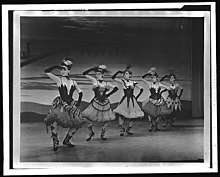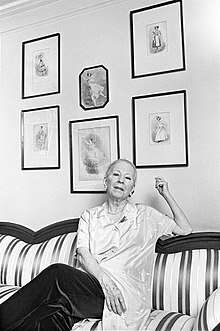Dream ballet
A dream ballet, in musical theater, is an all-dance, no-singing production number that reflects the themes of the production. The plot, themes, and characters are typically the same—although the people playing the characters may be different, as the roles of the dream ballet are usually filled by well-trained dancers rather than actual actors.

Dream ballet sequences exist mainly for clarification, foreshadowing, and symbolism, and occur outside the continuity of the production. They also advance the plot of the story through dance. Dream ballets also provide the opportunity to impress the audience with advanced dancing techniques and elaborate staging that would otherwise be impossible or dramatically inappropriate.
The dream ballet is thought to have originated in Rodgers and Hammerstein's 1943 musical Oklahoma!, which includes an 18-minute first-act dream ballet finale choreographed by Agnes de Mille.[1] The technique has since become a routine (although by no means universal) theatrical practice.[lower-alpha 1]
Elements of a dream ballet
A dream ballet is a moment in a musical, where the dialogue stops and the plot continues through movement. In Oklahoma!, the first time we see Laurey and Curly have a romantic moment is in the dream ballet. Likewise, what happens in the dream ballet, affects Laurey after she reawakens. This plot device makes the dream ballet unique in the world of musical theater.[1] Dream ballets are not to be confused with dance breaks. A dream ballet is a dedicated instrumental dance number, whereas dance breaks usually occur in the middle of songs. For example, the dance break in the middle of "Too Darn Hot" from Kiss Me, Kate! would not be considered a dream ballet because it is in the middle of a song with words. Also, it is there with the express purpose of dancing, not to move the plot forward.
Musicals featuring dream ballets
| Title of Musical | Title of dream ballet | Original Choreographer | Year |
|---|---|---|---|
| Oklahoma! | "Laurey Makes Up Her Mind" | Agnes de Mille | 1943 |
| Carousel | "Billy Goes on a Journey" | Agnes de Mille | 1945 |
| Brigadoon | "Ballet" | Agnes de Mille | 1947 |
| Guys and Dolls | "Crapshooters Ballet" | Michael Kidd | 1950 |
| Wonderful Town | "Ballet at the Village Vortex" | Donald Saddler | 1953 |
| The Pajama Game | "I'll Never Be Jealous Again Ballet" | Bob Fosse | 1954 |
| West Side Story | "Somewhere Ballet" | Jerome Robbins | 1957 |
| Bye Bye Birdie | "How to Kill a Man" | Gower Champion | 1960 |
| Fiddler on the Roof | "Chaveleh" | Jerome Robbins | 1964 |
| The Wiz | "Tornado" | George Faison | 1974 |
| Cats | "The Jellicle Ball" | Gillian Lynne | 1981 |
| Song and Dance | "Variations" | Anthony van Laast | 1982 |
| The Wild Party | "Jackie's Last Dance" | Mark Dendy | 2000 |
| An American in Paris | "An American in Paris" | Christopher Wheeldon | 2015 |
Dream ballets in film
_trailer_4.jpg)
After Oklahoma! debuted onstage, some movie musicals began to incorporate dream ballets into their creations. One notable example is An American in Paris (1951). Directed by Vincente Minnelli and choreographed by both Minnelli and Gene Kelly, the last twenty minutes of the movie is a dream ballet where Kelly's character Jerry Mulligan examines his relationship with Lise Bouvier, played by Leslie Caron. The dream ballet is supposed to stylistically move from painter to painter as Jerry thinks about his relationship in terms of different painters from Paris.[3]
Another Vincente Minnelli film to feature a dream ballet is The Band Wagon (1953) starring classic film dancers Fred Astaire and Cyd Charisse. Based on the musical of the same name, the dream ballet number "Dancing in the Dark" featured choreography by Michael Kidd. In 1954, Stanley Donen directed Seven Brides for Seven Brothers which featured a "Barn Dance" where the seven sisters are fought over by the seven brothers and their rivals. As he was popular at this time, the choreography was by Michael Kidd.
Oklahoma! debuted as a film in 1955, keeping Agnes DeMille's choreography for the dream ballet intact. Many additional musicals made the transformation from stage to the big screen including Brigadoon (1954), Guys and Dolls (1955), Carousel (1956), West Side Story (1961), and The Wiz (1978). These film versions tended to have big names as stars such as Gene Kelly, Marlon Brando, Frank Sinatra, Rita Moreno, and Diana Ross.
Since then other films have used the conceit of a dream ballet including the Coen Brothers' The Hudsucker Proxy (1994) which has an unexpected dream ballet number choreographed by Wesley Fata and performed by Tim Robbins and Pamela Everett[4] and The Big Lebowski (1998) featuring Jeff Bridges.
Notable choreographers of dream ballets

Agnes de Mille
Agnes de Mille had roots in the theater community with her father, William de Mille a Broadway playwright and a Hollywood screenwriter. Her uncle was Cecil B. DeMille, famous for his success as a Hollywood film director. Her family pressured her to pursue a playwriting career for herself, but she wanted to become a ballet dancer.[5] This didn't pan out as she would have liked, in spite of great efforts. She ended up attending UCLA for English and graduated with honors. However, she returned to the stage after moving to New York. She used solo dance recitals as a way to perform, refine her choreographic style, and garnered the interest of fellow theater makers. Agnes de Mille continued on this venture in London for an additional 5 years. In 1940 she helped found American Ballet Theatre back in the United States and choreographed some of their early work.[6] Her big breakthrough, however, came when she choreographed and danced the lead role for "Rodeo" for Ballet Russe de Monte Carlo in 1942.[7] She soon became an in-demand Broadway choreographer after that, working on musicals for stage and film for the next thirty years.
Michael Kidd
Michael Kidd grew up in New York City in the early 1900s. He started dancing in high school and while he started to pursue a college career in chemical engineering, he soon decided to become a ballet dancer instead. He joined American Ballet Theatre in 1937 and choreographed his first piece, On Stage!, in 1945. After getting a taste for choreography, he soon moved to Broadway and after gaining accolades in the form of Tonys for his choreography in Finian's Rainbow and Guys and Dolls, he became a popular Hollywood choreographer as well. Eventually Kidd added "Broadway director" to his list of accomplishments. His achievements include five Tonys for choreography and an Honorary Academy Award, which he received in 1997.[8]
References
- Filmer, Paul (1999). "Oklahoma!: Ideology and Politics in the Vernacular Tradition of the American Musical". Popular Music. 18 (3): 388–391 – via JSTOR.
- Polygon (2019-04-07), The Perfect PokéRap | Unraveled LIVE at PAX East 2019, retrieved 2019-04-08
- "An American in Paris Notes". TCM Archives.
- "The Hudsucker Proxy". imdb.com.
- Epstein, Daniel Mark (1994). "DANCE: American Dryad: Agnes De Mille". The American Scholar. 63: 591–600 – via JSTOR.
- "Agnes DeMille Dances - Biography". www.agnesdemilledances.com. Retrieved 2019-05-05.
- "ARTSEDGE: Master+Work: Agnes de Mille and Rodeo". artsedge.kennedy-center.org. Retrieved 2019-05-08.
- "Remembering the Legendary Michael Kidd". L.A. Dance Chronicle. 2018-12-21. Retrieved 2019-05-08.
- Notes